
US Inflation Data and the Thanksgiving Holiday
The US market remains influenced by the recent elections and the formation of the new government. Despite rising financing costs, existing home sales saw a boost and a more hawkish tone in Fed speaker comments supported by strong labor data and increasing PMIs.
Across the Atlantic, the picture was different. European sentiment surveys declined in November, signaling a challenging economic growth outlook for 2025 amid persistent global inflation pressures. With these expected growth challenges, central banks in Europe and beyond are likely to continue easing monetary policies cautiously next year. Meanwhile, inflation data from the U.K., Japan, Canada, and the Eurozone indicate that inflation remains sticky rather than easing.
Amid these developments, the financial markets were abuzz last week with speculation about Bitcoin, as investors wondered whether it might finally reach the $100,000 milestone.
Looking ahead, the coming week promises a wealth of economic data from around the world, central bank meetings, and key inflation numbers. As we inch closer to closing the current year, these developments pave the way for a potentially brighter economic outlook in 2025.
USA – Review and Outlook!
The most important data for last week was the US housing market figures. Despite positive data, sales remain sluggish at an annualized pace of 3.96 million, due to persistent affordability issues and tight inventory. The average 30-year rate climbed to 6.8% by late November, reversing earlier declines. However, sales increased by 3.4% in existing home sales following two months of declines, thanks to lower rates in summer. Still, housing starts fell 3.1% in October, affected by hurricane disruptions and cautious sentiment among homebuilders, though broader trends show weakening multifamily activity amid tight credit and oversupply concerns.
On Tuesday next week, we will have the new home sales and CB consumer confidence numbers, where we are expecting to see more positive data from the housing market and consumer confidence in spending with optimism on the new government in the White House. However, challenges persist, including high borrowing costs, limited inventory, and potential policy headwinds. While new home sales may hold up better due to incentives like mortgage rate buy-downs, the broader housing sector remains constrained by financing pressures and affordability challenges.
Where consumers spend their money will be clearer on Wednesday, when we are going to have the US durable goods orders. Durable goods orders likely steadied in October, with a forecast 0.3% increase overall and 0.2% excluding transportation. Boeing’s steady aircraft orders offset some volatility, though strikes may have weighed on production. While demand is stabilizing, uncertainty over rate cuts and future tariff policies cloud the capex outlook.
Wednesday we will have another important number, the focus of the week. We are positive about personal spending and income, as retail sales also rose 0.4% in October, with upward revisions to prior data signaling that households are well-positioned for the holiday season. Broader spending, including goods and services, is expected to grow and increase personal spending as well. As for income, we expect the key driver of spending to have increased by 0.3% despite a slowing labor market. While inflation is cooling, higher prices still pose challenges. The PCE deflator likely rose 0.2% in October, nudging the annual rate to 2.3%. With growth steadily and inflation above target, the Fed is expected to proceed cautiously in easing restrictions next year.
All past data and expected numbers say that we can give more chances to hold policy in the December meeting. According to the CME Group FedWatch tool, holding the current rate has more than a 47% chance, compared to 31% at the end of last week.
Stock Markets
Recent data suggest that stock bulls may face limitations and could come under pressure to relinquish control to the bears. In the SP500 chart, a strong support level is evident around 5,870. As long as this level holds, the bullish trend remains possible. However, a breach below 5,870 could pave the way for further declines, with the next support levels at 5,820 and 5,775.
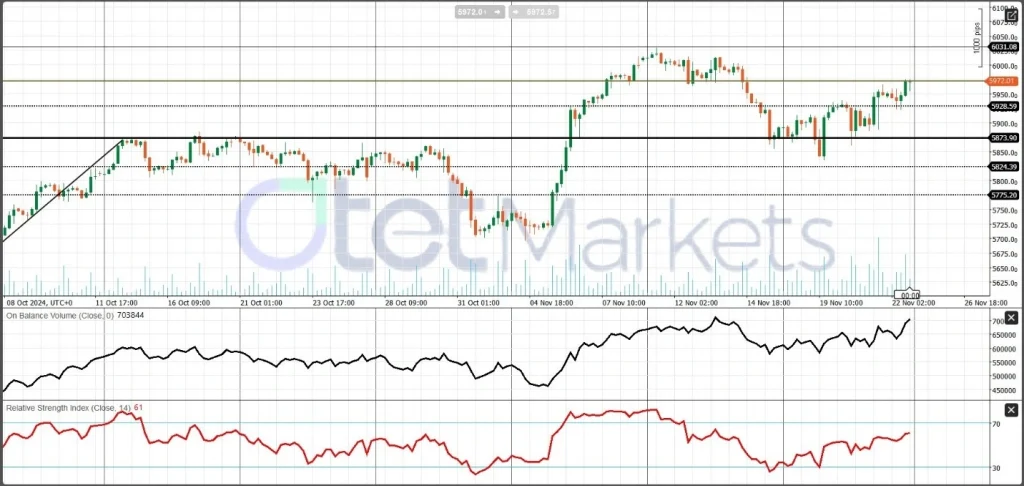
US Dollar
The U.S. presidential election continues to impact the dollar’s value, with the Treasury Secretary’s appointment still pending and expected to influence its direction. The President-elect’s economic policies could prompt the Federal Reserve to pause its rate-cutting cycle. Fed Chair Powell recently stated that there is “no urgency to lower rates,” signaling a cautious stance amid ongoing economic uncertainty. This suggests the U.S. dollar index may maintain its current strength even if further gains are limited.
From a technical perspective, the 106 mark serves as a critical pivot level on the dollar index chart. A breach below 106 could bring the 105.20 level into focus, though this is unlikely in the short term, at least until the release of the PCE inflation data.
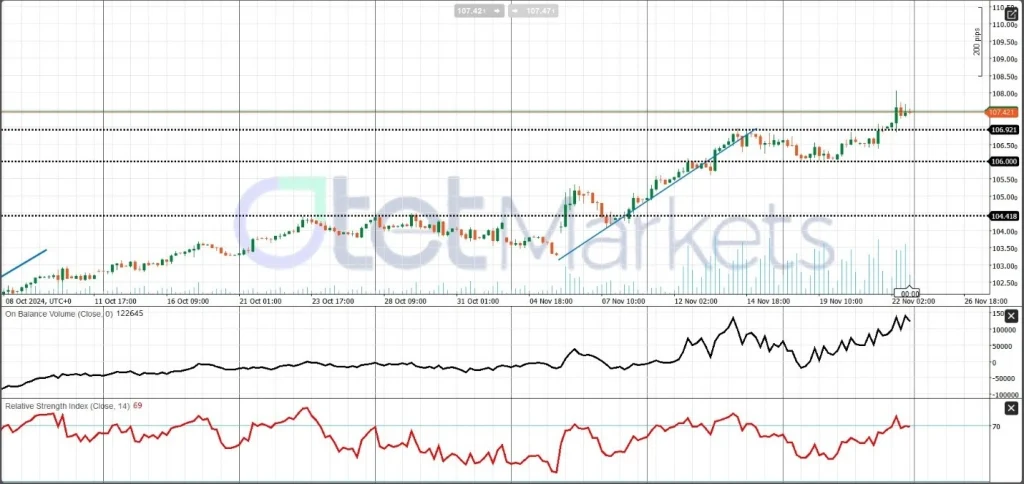
RBNZ Policy Meeting and Interest Rate Decision
The Reserve Bank of New Zealand (RBNZ) is expected to announce another significant 50 basis point rate cut at its upcoming meeting on Wednesday, which would lower the policy rate to 4.25%. In its October meeting, the RBNZ had already cut its Official Cash Rate (OCR) by 50 basis points to 4.75%, aligning with market expectations. In its policy statement, the RBNZ emphasized its focus on maintaining low and stable inflation while minimizing disruptions to output, employment, interest rates, and the exchange rate.
The RBNZ’s minutes highlighted that annual inflation has fallen within its 1% to 3% target range, moving toward the 2% midpoint. In the second quarter of 2024, New Zealand’s annual inflation rate was 3.3%, showing a clear downtrend in recent months. This rate cut reflects the central bank’s ongoing efforts to support stable economic conditions amid easing inflation pressures.
Recent economic data supports this outlook, with the Q3 labor market report showing a 0.5% drop in employment and an increase in the unemployment rate to 4.8%. Additionally, wage growth moderated, and CPI inflation slowed to 2.2% year-over-year in Q3. Given these conditions, we expect the RBNZ to maintain its aggressive stance and implement another 50-basis-point cut in November. For 2025, we anticipate a more gradual pace of rate cuts.
In response, we expect the NZD/USD to continue its downtrend, with further pressure on the Kiwi. From a technical perspective, the first key resistance level sits at 0.5910. Trading below this level could maintain the downtrend, while a recovery above it would likely result in a short-lived recovery for this currency pair.
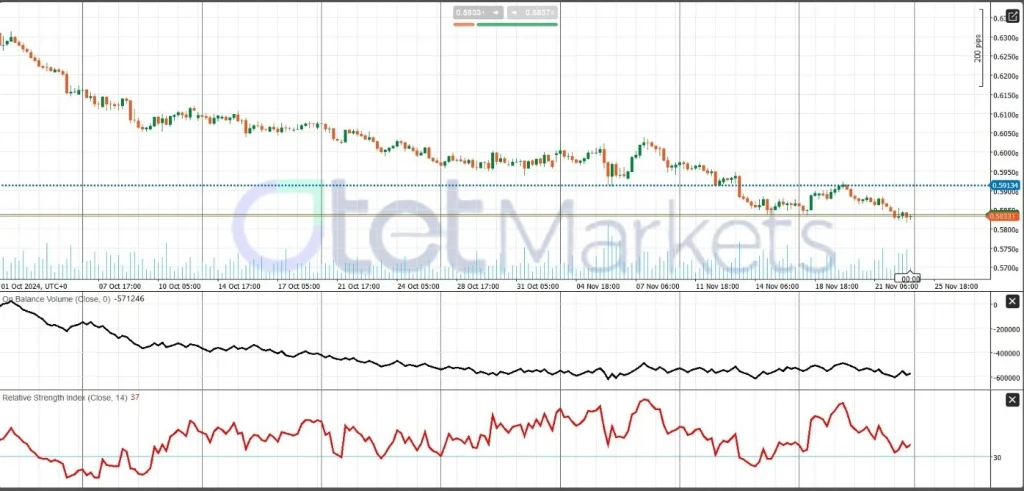
Gold eyes on $3,000!
Gold Futures experienced extreme public sentiment last week due to concerns over global tensions, U.S. political issues and elections, and a slowing economy, particularly in the U.S. Speculators, as reflected in the Commitments of Traders (CoT) data, showed over-bullish sentiment, which is typical of a bullish market like gold’s. It appears that gold is poised to climb again, potentially reaching its early 2024 target, when bulls were sharply heading toward $3,000.
After nearly three weeks of decline, gold rebounded, rising 5.3% this week to surpass $2,700. Investors are seeking gold as a safe haven amid geopolitical tensions, particularly the ongoing Russia-Ukraine conflict, which has intensified again. In addition, economic pressures like the weakening euro and the Eurozone economy, amid Germany’s political crisis, are contributing to the demand for gold. Gold’s recovery above the 50-period moving average at $2,650 on the H4 chart (and most important timeframes) is a key technical signal for potential further gains.
On top of that, according to the AP, the U.N. nuclear watchdog’s board condemned Iran on Thursday for not fully cooperating with the International Atomic Energy Agency (IAEA), marking the second such condemnation in five months. The IAEA called on Iran to provide answers regarding a long-standing investigation into uranium particles found at two undeclared sites. In response, Iran’s Atomic Energy Organization and foreign ministry criticized the resolution, with Iran’s nuclear chief, Mohammad Eslami, ordering the development of new advanced centrifuges to enrich uranium.
With ongoing tensions and concerns over profit-taking in the stock markets, gold is likely to remain in demand, with $2,700 now serving as a strong support level.

Oil and Energy Market Update
Oil prices are fluctuating largely due to geopolitical tensions, with U.S. crude rising above $70 per barrel. However, ample supply and weak demand have capped gains between the $70-$73 range. These conditions favor bullish sentiment, especially if positive economic data emerge.
Geopolitical risks, including escalating tensions from the Russia-Ukraine war, the Israel-Lebanon conflict, and instability in parts of the Middle East, are weighing heavily on markets. President Biden’s approval of advanced missile systems and landmine use in Ukraine has intensified the conflict, complicating peace prospects and raising the likelihood of Russian retaliatory actions. Reports of a meeting led by Russian President Putin have further added uncertainty, keeping oil markets on edge.
As noted earlier, the Islamic Republic of Iran has also escalated its nuclear activities following a U.N. censure, increasing tensions with the West. This development adds further volatility to energy markets, particularly given the Middle East’s critical role in global oil supply.
Meanwhile, colder-than-average winter forecasts, especially in Europe, are driving up natural gas and heating demand. London has experienced its coldest start to winter in five years, leading to a surge in energy consumption. Concerns about global energy security continue to mount, which could push prices higher.
From a technical perspective, conditions remain similar to last week, with sideways movement dominating but growth potential emerging above the $67 level.
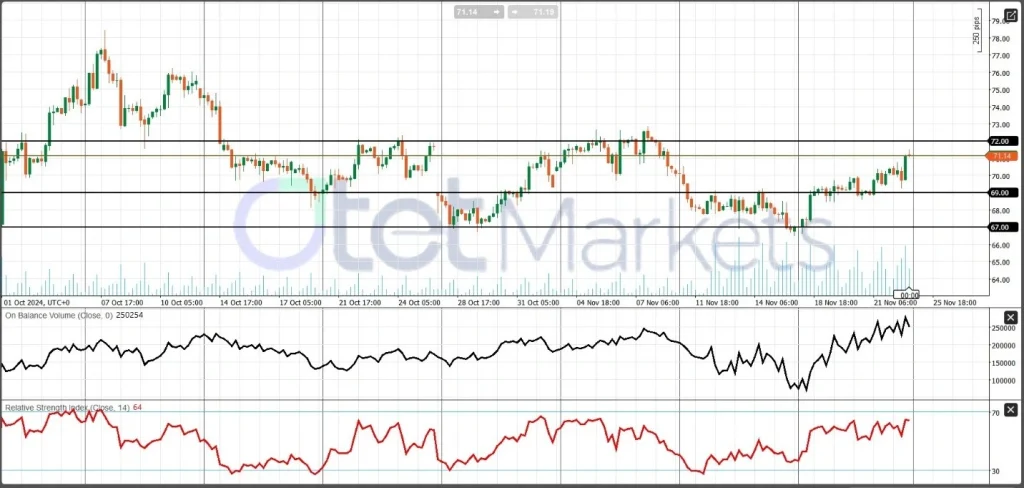
Bitcoin Surpasses $99,000, Eyeing $100,000 Milestone
Bitcoin has reached a new all-time high, surpassing $99,000, driven by record inflows into spot BTC-ETFs and positive market sentiment. The surge is attributed to optimism surrounding Donald Trump’s election as U.S. president, known for his pro-crypto stance, and the launch of BlackRock’s iShares Bitcoin Trust on Nasdaq. Institutional interest in options tied to this trust has fueled market activity, with analysts predicting Bitcoin could surpass $100,000 as part of a “Santa Claus rally.” For now, breaking the psychological $100,000 barrier is the key focus for investors and traders.
Technical Overview
From a technical perspective, Bitcoin is in a strong uptrend that began in mid-October, with the price forming consistent higher highs and higher lows. The price is now approaching the $100,000 level, which serves as a significant psychological resistance.
- 20-Period EMA: The price remains well above the 20-period EMA (dotted line), reinforcing the bullish momentum. This EMA has acted as dynamic support throughout the current rally.
- Average Directional Movement Index (ADX): The ADX rating of 39 suggests a very strong trend. Additionally, the Positive Directional Indicator (+DI, red line) is above the Negative Directional Indicator (-DI, green line), further indicating a robust uptrend.
- Bulls Power (13, Exponential): The indicator shows significant bullish strength, with bars consistently above the zero line and growing during the recent price surge.
Key Levels
- Resistance: The $100,000 level is a major psychological barrier. If breached, it could lead to further bullish momentum.
- Immediate Support: The 20-period EMA, currently around $94,839, offers the first level of dynamic support.
- Additional Support: Previous resistance at $90,000, which saw multiple price touches before the breakout, may now act as a strong support level.
Outlook
If Bitcoin maintains its position above the 20-period EMA and the ADX remains elevated, the bullish trend is likely to continue, with a potential breakout above $100,000. Conversely, a drop below the 20-period EMA, coupled with a +DI crossover below -DI, could signal a weakening trend and a test of lower support levels at $94,839 or $90,000.
Overall, the chart shows strong bullish momentum supported by technical indicators. Traders might consider buying on dips towards moving averages, while closely monitoring the $100,000 resistance and support levels at $94,839 and $90,000 for potential reversals or breakouts.
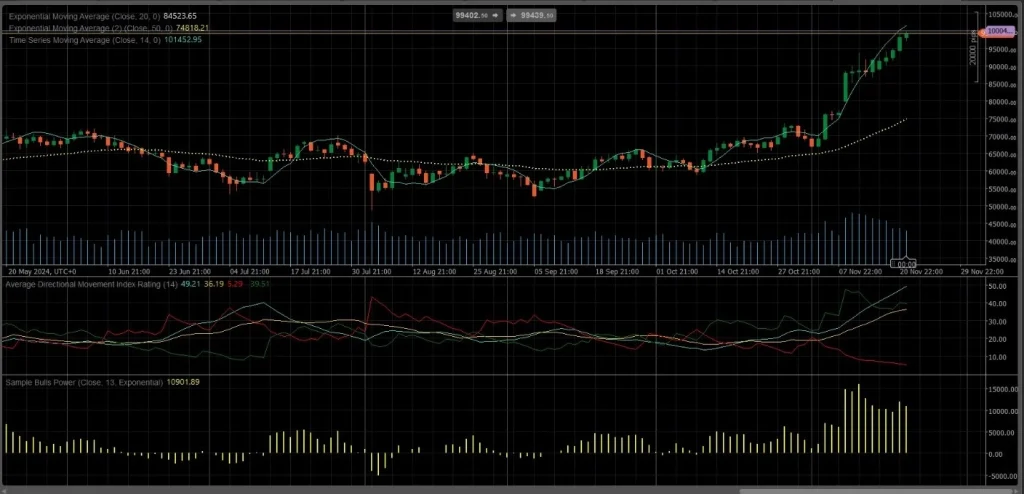
Share
Hot topics

Best Forex Trading Hours for Iranian Traders
The Forex market operates 24-hours a day, but clearly not every hour, equal it could even be every trading session, is profitable. There are times when the market sleeps, is...
Read more




Submit comment
Your email address will not be published. Required fields are marked *